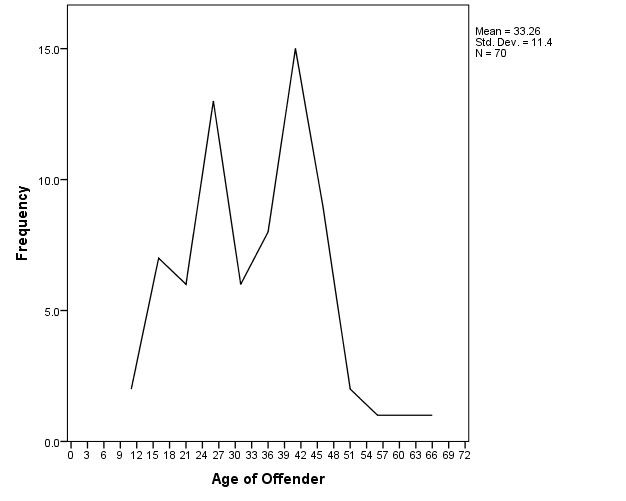Attention
Mass Killings: An Evolutionary Perspective
Some aspects of mass killings are clearer—especially those by older men.
Posted October 4, 2017
(Typically, I wait until our work has gone through peer review before blogging about it. This work is technically in review at the moment, but several people (including journalists) have asked about it for reasons that will shortly become obvious.)
Mass Killing
Mass killings are unusual events but devastating when they occur. Although the absolute risk of dying at the hands of such a killer is low, people stubbornly refuse statisticians’ earnest assurances of relative safety. This should not surprise us. Mass killings are, among many other things, a deliberate attempt to drive a wedge into the existing social order. That is why they are public, and why the killer seeks to maximise attention, and rarely seeks to escape. Some of these motives are obviously political—the intent is to sow fear and destabilize government--and I am not going to have anything much to say about those. What about people with more individual motives?
Attention to our evolved natures can cast some light on this. (1) Notice I say some light. The evolutionary perspective adds depth to existing accounts—it is an “added value” aspect of psychology, not a replacement for other—more local—explanations such as individual pathology, or why a location or victim was chosen.
I’ve likened the evolutionary account of a trait, to knowing the etymology of a word. For instance, knowing that the origin of the word “lemur” (those beautiful dark-eyed primates) comes from the Latin for “spirits of the dead” adds something to our understanding of the word. Not everything. Something. Sorry to have to keep saying this but, well, apparently I have to keep saying this. Let’s move on.
Status
“Woman up!”
“Be a woman about it”
“How do you expect any man to be attracted to you if you don’t have a good job?”
“What do you mean you are ‘sick’? That’s just ‘woman flu’”
“Girls don’t cry”
Male humans swim in worlds of status like trout swim in complex currents of water. Anyone who is not aware of this (or in denial about it) finds things like the high rates of male suicide or the fact that males are massively over-represented in apparently senseless crimes, utterly baffling. (2) Glib talk of “toxic masculinity” barely scratches the surface of what is going on. (3) “Toxic” does not explain the half of it, and it is worth noting that even the most toxic of masculinity does not put off all possible sexual partners. As Ogas and Gaddam (2012) note “It turns out that killing people is an effective way to elicit the attention of many women: virtually every serial killer, including Ted Bundy, Charles Manson, and David Berkowitz, has received love letters from large numbers of female fans” (p. 98). (4)
Remember—we have done the genetic analysis and most males (60 percent) do not reproduce. Status is exquisitely linked to male reproductive success, and males who were blind to its ups and downs have simply not had descendants. Call it “face”; call it “honor”; call it “status” or call it “prestige”. We are all descended from men who cared about it. (5)
We might have tamed it somewhat in modern society. We give it useful outlets. Sport. Awards at work. Elaborate rituals where we show that a person has so much status to spare, that they can even survive being roasted by professional comedians. Sometimes, in some individuals, and for reasons that we still do not understand, this pressure to value status can go very badly awry.
This has happened across time and space. There is even a Malay word, “Amok” which has passed into the language as “running amok”. Young (usually) Malay men would, for reasons unknown, attack innocent bystanders, usually with knives, sometimes with grenades. We used to think that this was what was called a “culture bound syndrome”, but we know better now. Indeed, “amok” has been dropped from the current DSM-5. Instead, we have “rampage” or “spree” killers. For simplicity sake I shall group all these together as “mass” killings—where five or more people, often unknown to the perpetrator, are killed—sometimes in multiple locations. (6)
Data Gathering
We carried out an archival study of seventy mass killers going back nearly a hundred years. Our methodology was highly conservative. We relied on only using archival accounts where we could double (or triple) up on the independent corroboration of details. Media tends to get highly speculative (and often political) about these events, and we did not want to get taken down any garden paths. In addition, we restricted the search to North America—for a couple of interesting reasons.
One—the ready presence of firearms makes the expression of such murderous desires much easier to compare between events. For instance, once we started to search we found a host of mass killing attempts across the world. But many of these used knives, or vehicles, and thus tended to injure rather than kill. We have little doubt that these people had exactly the same murderous intents—but they could not carry them out as effectively.
Two, America has an efficient (some would say intrusive) media. It was comparatively easy to obtain a decent level of archival detail.
Analysis
Latent Class Analysis is a great statistical technique that allows you to feed a bunch of different types of data in at one end, and crank out otherwise hard to notice patterns at the other. So that’s what we did. We fed in as much data as we could get—age, numbers of victims, type of clothing worn, personal history, recent personal events, and so on, turned the statistical handle, and saw what patterns emerged.
What we found was very interesting, and a reminder that averages can often be highly misleading. Although the average age for the mass killers in our sample was 33, this number was highly unrepresentative of the population. The range of ages was from 11 (yes, really) to 66—which is pretty broad in and of itself. Even more interesting was that the distribution of ages had two peaks (what is technically called a “bimodal” distribution). And—this is the really surprising part, the two groups that clustered around these age peaks could not have been more different from one another.

The younger group (average age 23) tended to have been in trouble with the law, they were more likely to have had mental illness. In other words—at the age where young men are acquiring status, and the skills and abilities that will enable them to do so—they were, in fact, acquiring signs that they were on a fast track to reproductive oblivion. In ancestral times—times without highly trained and equipped SWAT teams--a “Hail Mary” attempt to attract attention and make ‘them’ take you seriously might (just might) have worked. This age group also tended to be less likely to be killed during their killing spree, and follow-up work we are doing suggests that many of this type do attract a significant amount of female attention when in prison. (7)
The older group (average age 41) were much more likely to be married, and maybe have families. They were less likely to have had prior signs of legal issues or of mental illness. But a peek into their personal details (so far as we were able) revealed that they had a pattern of recent status loss--or threat of same. A job. A relationship. Custody battles. A looming scandal. These older guys were not so much trying to acquire status, their actions looked more like a highly pathological attempt to not lose it. No more rational than the desperate “If I cannot have you then no-one can” actions of a jealous murderer, the role of status possibly sheds some light on their final act.
These age clusters map pretty closely onto the curves for male reproductive fitness. As men acquire status they fit the first type, as they potentially lose it, they fit the second.

Male and female mate value compared
A lot of things did overlap between the groups. Reputational slights are, especially when we are talking about paranoid and unstable individuals, somewhat in the eye of the beholder. We might never be able to see all of these events coming. Specifically, we have no insight into what particular actions and victim selection means to the perpetrator. But, without the realization that status is likely to always be a component of that meaning, we will not have a complete picture. (8)
References
1) Buss, D. M. (2005). The murderer next door: Why the mind is designed to kill. New York: Penguin.
Daly, M., & Wilson, M. (2008). Homicide. New Brunswick, NJ: Transaction Publishers.
2) Wilson, M., & Daly, M. (1985). Competiveness, risk taking, and violence: The young male syndrome. Ethology and Sociobiology, 6, 59-73.
3) Michael Mills has already done an excellent job exploring many aspects of this. If you are interested in this toipic and have not yet read this--then read it now
https://www.psychologytoday.com/blog/the-how-and-why-sex-differences/20…
See also Harrison, M. A., & Bowers, T. G. (2010). Autogenic massacre as a maladaptive response to status threat. The Journal of Forensic Psychiatry & Psychology, 21(6), 916-932.
We see our study as building on the insights offered above
nb. An earlier version mislabelled Michael Lowrys graph showing putative reproductive value as Michael Mills graph showing reproductive variance. I am grateful to both gentlemen (and scholars) for pointing out my error.
I was planning to show a graph on reproductve variance as well but thought this would confuse readers. I was half right. I ended up confusing only myself. Apologies for any misunderstandings.
Since I produced this post my attention has been drawn to this earlier one
https://www.psychologytoday.com/blog/out-the-ooze/201512/if-you-give-ma…
Absolutely! I see our work as building on this too. Drilling down into the complex nature of status (for instance how it changes across age) is the next step to recognising how crucial status is to understanding motive in men. I suspect that we also drastically under-estimate the level of female competition out there and the various forms (typcially non lethal) that it takes
4) Ogas, O., & Gaddam, S. (2012). A billion wicked thoughts: What the internet tells us about sexual relationships. New York: Dutton.
6) Palermo, G. B. (1997). The berserk syndrome: A review of mass murder. Aggression and Violent Behavior, 2(1), 1-8.
Westermeyer, J. (1973). Grenade amok in Laos: A psychosocial perspective. International Journal of Psychosocial Psychiatry, 19, 1-5.
St Martin, M. L. (1999). Running amok: A modern day perspective on a culture-bound syndrome. Primary care companion journal of clinical psychiatry, 1(3), 66-70.
7) Dahlen, M., & Soderlund, M. (2012). The homicidol effect: Investigating murder as a fitness signal. The Journal of Social Psychology, 152(2), 147-157
8) Butler, N., & King, R. (In review). Running Amok? Latent Class Analysis Reveals Surprising Patterns in Spree-Killings.
There were three female killers in our sample but this was too small a group for proper analysis.
5) Wilder, J. A., Mobasher, Z., & Hammer, M. F. (2004). Genetic evidence for unequal effective population sizes of human females and males. Molecular Biology and Evolution, 21(11), 2047-2057




